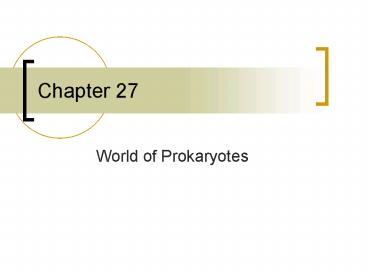World of Prokaryotes PowerPoint PPT Presentation
1 / 24
Title: World of Prokaryotes
1
Chapter 27
- World of Prokaryotes
2
Everywhere
- Contain the most biomass of any living thing
- Live in extreme conditions
- Mostly only hear about disease causing bacteria,
but most are very helpful - Cycle nutrients
- Provide us with vitamins
- Live in symbiotic relationships with some
organisms
3
Bacteria and Archaea
- Two main branches of prokaryote evolution
- Archaea inhabit extreme conditions
- Bacteria are the most commonly studied
prokaryotes - Five Kingdom system has been reworked into a
three domain system
4
Structure and Function
- Unicellular
- Some form colonies with division of labor
- Cell shapes among prokaryote
- Spheres cocci
- Rods bacilli
- Helices spirilla
- Diameters range from 1-5 um
- Eukaryotes range from 10-100 um
5
Structure of Prokaryotes
- Cell walls exist external to plasma membrane
- Contain peptidoglycan (plants use cellulose)
- Walls of Archaea do not contain peptidoglycan
- Gram positive and gram negative stains
- Useful for identifying bacteria
6
Gram stain
7
Mobility
- Half of all prokaryotes are capable of
directional movements - Most use flagella
- Flagella can be scattered over the cell surface
or concentrated at one or both ends
8
Mobility
- Spirochetes helix shaped bacteria, with basal
motor powered filaments propel the organism like
a cork screw - Some secrete slime then as the slime grows the
bacteria can move - Flagellated bacteria are capable of taxis
9
Cellular and Genomic Organization
- Prokaryotes differ from eukaryotes in this topic
- Remember that prokaryotes have no nucleus
enclosed membrane - They do however have specialized membranes that
do specific jobs - Prokaryotes have smaller genomes
- 1/1000th as much DNA as eukaryotes
- One chromosome in ring form
10
Plasmids
- Accessory pieces of DNA
- Normally not needed
- Some give resistance to antibiotics,
- And can be transferred from one bacteria to
another
11
Growth and Adaptation
- Reproduce by binary fission
- Not meiosis or mitosis
- They do reproduce asexually, but they can
transfer genes from one individual to another - Transformation cell takes up genes from the
environment - Conjugation direct transfer of genes from one
individual to another - Transduction viruses transfer genes from one to
another
12
Adaptation
- Generations are measured in minutes
- Favorable mutations can be rapidly propagated
into the population - Endospores dormant state for a bacteria to
survive harsh conditions - Some can last for 250 million years
13
Nutrition and Metabolic Diversity
- Nutrition refers to how an organism obtains
energy and a carbon source - Phototrophs use light energy
- Chemotrophs use chemical energy
- Autotrophs need only CO2 as a carbon source
- Heterotrophs require at least one organic
molecule as a carbon source
14
Nutritional and Metabolic Diversity
15
Prokaryotic Diversity
16
Domain Archaea
- Archaea are sometimes called extremophiles
because they thrive in difficult areas - Methanogens use CO2 to oxidize H2 producing
methane as a byproduct. - Poisoned by oxygen
- Extreme halophiles live in very salty seas and
lakes - Extreme thermophiles - live in deep water vents,
and - Two main groups
- Euryarchaeota methanogens and halophiles
- Crenarchaeota - thermophiles
17
Domain Bacteria
- Most known prokaryotes are bacteria
- Five main groups (several have been omitted)
18
Proteobacteria
- Large and diverse group containing both gram
negative and positive individuals - Alpha this group has close relationships with
eukaryotes - Beta contains nitrogen fixing bacteria
- Gamma E. coli
- Delta myxobacteria, form elaborate colonies
- Epsilon Helicobacter pylori
19
Chlamydias
- Parasites on animal cells
- Most common cause of blindness in the world
- Most common STD in the US.
20
Spirochetes
- Helical shaped heterotrophs
- Most are free living
- But some parasitic like the species that causes
syphilis
21
Gram-positive bacteria
- Very diverse group
- Some very close relatives of gram-negative
bacteria in this group
22
Cyanobacteria
- Plantlike photosynthesizers
- Abundant in wherever there is water
23
Ecological Impact of Prokaryotes
- Decomposers
- Symbiotic relationships
- Mutualism
- Commensalism
- Parasitism
24
Human Diseases
- Most of us have harmful bacteria living on or in
us now - When resistance is low we can become sick
- Opportunistic diseases
- Bacteria also produce exotoxins and endotoxins
- Exotoxins botulism (1 g of toxin is enough to
kill 1 million people) - Endotoxins toxins present on the walls of
bacteria - Salmonella

